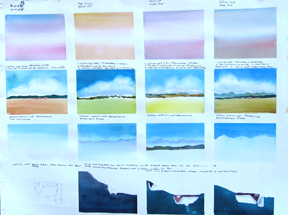
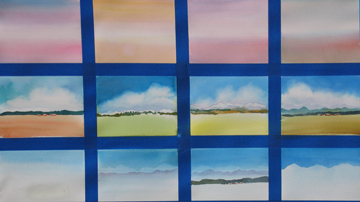
MASS PRODUCING PAINTINGS? This is fun and you may be surprised at how many turn out. Here is a sheet of 12 (plus 4 more that don’t count for this).
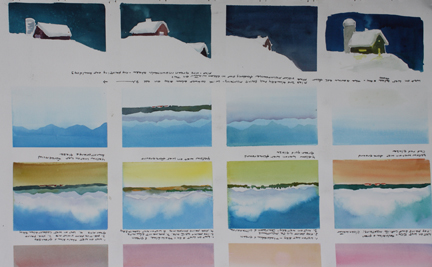 Or here it is upside down or is that right side up?
Or here it is upside down or is that right side up?
And here is another one.
What, you wonder, is going on?
You can call it mass producing paintings, or practicing an idea, 4 at a time, or whatever you wish. I have found that when students do these sheets they relax and have fun. Some are bound to turn out! And, along the way, they find they are solving problems and mastering techniques. This was described somewhat differently in last November’s Technique corner. If nothing else, I am making the photographs larger!
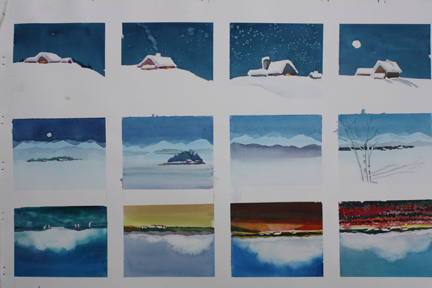 What have we done?
What have we done?
First, soaked and stretched a full sheet of Arches 140 lb cold press. Of course you can use other sizes of paper, but do stretch (see June, 2009 technique) and tape them with a painters’ tape that won’t leak.
Measuring for the width of the tape, we have made 4 across and three down. Take your envelopes, if you may use some for cards, and measure backwards from their size. Or if you are thinking small frames, tape for the opening: 5×7 or 8×10
 A little snow scene such as this one is the fastest. In the first photo of the full board, notice that the row of little buildings is upside down. that is how you paint them.
A little snow scene such as this one is the fastest. In the first photo of the full board, notice that the row of little buildings is upside down. that is how you paint them.
- First draw simple little buildings, high in the rectangle with overhanging snowy roofs and a sloping ground.
- Then turn your board upside down.
- Prop it so that it slopes with a steep angle.
- Mix a large puddle of very dark paint. I use a combination of pthalo blue, pthalo green and quinacridone violet.
- Paint the sky. In this example you would have started on what is now the lower right and worked from that side to the other (actually left to right), painting down (up) from your pencil line around the buildings, the ground and the snowy roofs.
- Leave a bead of paint collecting on the bottom of your stroke.
- Refill your brush and continue,going from one side to the other until you reach the tape at the bottom.
- Refill your brush and start with your next drawing, continuing as you did in the first.
- If you wish to have smoke coming out of the chimney, blot off some paint as the shine goes off your sky.
- Decorate the snowy roof by putting a soft shadow on the UNDER edge (not along the top).
- Paint your building a dull color. If you want yellow windows, paint them first and let them dry before painting the building. Be careful about yellow light on the snow.
Fun?
The blue mountains are done the same way, but in layers. So they take more time. But you may do them 4 at a time!
 If you look at the photograph at the top of the article (third row), you will see that the first example on the left has a light blue wash, darker at the top and all the way to clean paper as it goes down. This is the color of your lightest ridge of mountains.
If you look at the photograph at the top of the article (third row), you will see that the first example on the left has a light blue wash, darker at the top and all the way to clean paper as it goes down. This is the color of your lightest ridge of mountains.
On the far right of the same row, you see what has happened after drawing in a range of mountains, turning the board upside down and painting a second blue from the edge of the range down to the top of the image. Now you have a shape to the mountains.
With the two close-up examples here, the lightest mountains are this range you see started on the right at the top of the article.
We also have another more distant range. This was achieved by drawing in another range into the second glaze of blue sky, and painting the sky yet again. This time from the top of the new range of mountains to the top of the painting. Only remember — have the board upside down and at an angle so the paint drawings AWAY from the mountain’s edge.
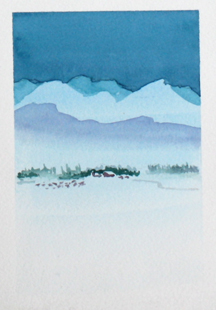 The nearer, third range of darker hills is added after the paper is dry. Now the board is facing the normal way, but still on an angle.
The nearer, third range of darker hills is added after the paper is dry. Now the board is facing the normal way, but still on an angle.
I mixed up a soft violet and drew a line of clean water across where I wanted my range to fade into mist. Then I painted down to that waterline, letting the color disappear.
When that was dry, I “decorated” each painting with low farm buildings, trees, a second line of hills. The paintings may have started 4 at a time but are pretty individual by the time they are done.
 The last photo shows another variation. Ink was used on the near shapes. You can take your mass-produced starts into all kinds of different directions.
The last photo shows another variation. Ink was used on the near shapes. You can take your mass-produced starts into all kinds of different directions.
An since you asked, the middle row is wet on wet sky paintings with glazed foregrounds, We will save those until another time.
There are other examples for cards in November and December of 2008.
Have fun! Keep it merry!!
Caroline
©Caroline Buchanan 2009
